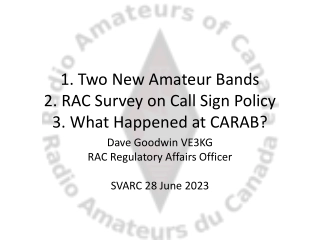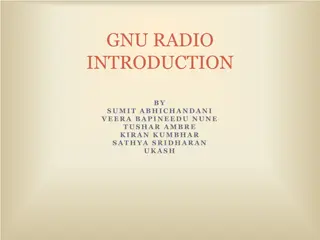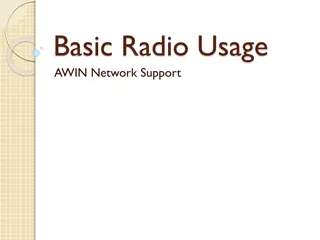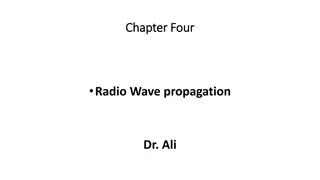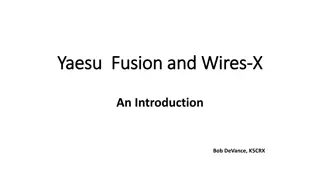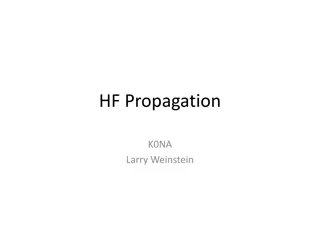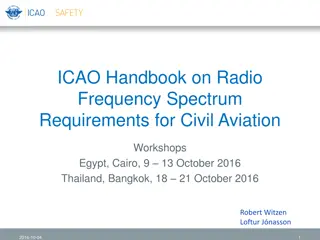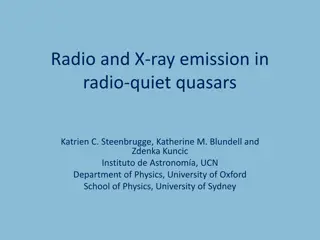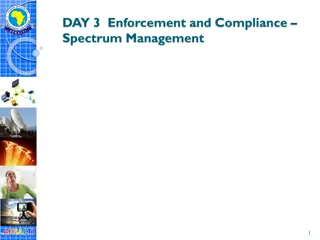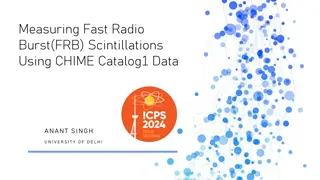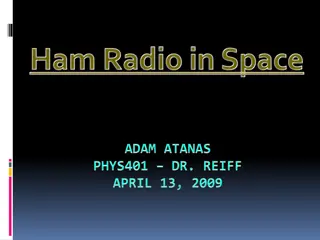Applications of Spectrum Analyzer in Amateur Radio
The spectrum analyzer is a crucial tool in amateur radio for analyzing signals in both time and frequency domains. It enables representation of various signals like audio, ultrasonic, and RF. By utilizing techniques such as the Fourier transform, signals can be converted from time to frequency domain for detailed analysis. The history of oscilloscopes and the evolution of the oscilloscope technology are also discussed, highlighting the transition from analog to digital scopes. The frequency domain display of spectrum analyzers allows for in-depth analysis of signal amplitudes across frequency bins, providing valuable insights for radio enthusiasts.
Download Presentation

Please find below an Image/Link to download the presentation.
The content on the website is provided AS IS for your information and personal use only. It may not be sold, licensed, or shared on other websites without obtaining consent from the author.If you encounter any issues during the download, it is possible that the publisher has removed the file from their server.
You are allowed to download the files provided on this website for personal or commercial use, subject to the condition that they are used lawfully. All files are the property of their respective owners.
The content on the website is provided AS IS for your information and personal use only. It may not be sold, licensed, or shared on other websites without obtaining consent from the author.
E N D
Presentation Transcript
THE SPECTRUM ANALYZER APPLICATIONS in AMATEUR RADIO A Vienna Wireless Society Presentation by Lee Garlock, KD4RE Assisted by Ron Payne, WA6YOU
MODULE 1 THE BASICS
SIGNAL REPRESENTATION All time varying signals (audio, ultrasonic, RF, etc.) can be represented and plotted as a function of time or frequency. For a simple sinewave F(t) = sin(2 ft+ ) and F( ) = 2 f The principal for converting time domain data to frequency domain data is the Fourier transform developed by Jean-Baptiste Joseph Fourier (1768 1830) who was working on heat transfer. F( ) = f(t) * -j t dt The Fast Fourier Transform is a computer algorithm based on digital sampling of a signal that can compute the frequency components from time samples of a signal Requires sample sizes that are powers of two (e.g. 1024, 2048. 4096)
TIME DOMAIN DISPLAY Signals are displayed in the time domain on oscilloscopes. Amplitude on the vertical axis versus time on the horizontal axis. Amplitude is typical linear (volts/division) The first oscillographs used a galvanometer to record on a rotating paper drum or film in late 1890s. The CRT oscilloscopes first appeared in the WWI era. By the 1930s General Radio introduced a general used oscilloscope. Up through 1980s oscilloscopes were analog with CRT displays but developed sophisticated trigger circuits and bandwidths from several MHz up to 1 GHz. Today most scopes sold are digital with LCD displays and high end scopes have sampling rates in 10s of Gigasamples per second and GHz bandwidths.
A BASIC ANALOG OSCILLOSCOPE Vertical Amp Amplifier Trigger Circuit Saw Tooth Generator Horizontal Amp Time Base
FREQUENCY DOMAIN DISPLAY An Analog Spectrum Analyzer is basically a SUPERHETERODYNE receiver with a swept local oscillator (LO) and sometime linear detector with a display similar to an oscilloscope. Displays frequency on the X-AXIS and amplitude in the Y-AXIS. Most modern systems have a PEAK-HOLD function. Most have ZERO SPAN mode: LO is fixed and display is SIGNAL vs. TIME.
FREQUENCY DOMAIN DISPLAY Real Time Spectrum Analyzers are digital sampling systems that implement a Fast Fourier Transform to display power levels within frequency bins across the display. Can provide AMPLITUDE vs. FREQUENCY display like conventional analog analyzers. Can provide a WATERFALL DISPLAY (cascading FFTs over time). Most can show sample AMPLITUDE vs. TIME.
ANALOG SPECTRUM ANALYZER IF Filters (Resolution Bandwidth) YIG Filter (opt) IF Amp Log/Linear Detector Attenuator Video Amplifier and Lowpass filters Voltage Controlled Local Oscillator (Sweep Generator) Vert Amp Saw Tooth Generator Horizontal Amp Time Base
BASIC REAL-TIME SPECTRUM ANALYZER (SDR) RF Filters Low Pass Filter Signal Conditioner A/D Converter FFT Processor (software, FPGA, hardware) Local Oscillator (tunable in steps) Sample Rate Clock Tuner Unit Display System (Video and LCD) Key Factors: Tuner Frequency Range Sampling Rate (Bandwidth) Number of Bits Processor Speed for FFTs Control and User Interface Processor Unit
REAL-TIME SPECTRUM ANALYZERS COST RANGES $0.00 Software for PC (audio) $12 for 2 GHz, 8 bit 2 MHz instant + PC $3K for 6 GHz, 14 bit , 30 MHz instant + PC $250K (26 GHz, 14 bit, 150 MHz instant )
MODULE 2 SPECTRUM ANALYZER CONTROLS and LIMITATIONS
SPECTRUM ANALYZER CONTROLS Major Controls REFERENCE LEVEL (maximum displayed amplitude) & Input Attenuation. START and STOP Frequencies of Display (or Center Frequency and Span). RESOLUTION BANDWIDTH (width of IF filters) and Video Bandwidth. SWEEP TIME. LOG/LINEAR DISPLAY on some units and dBm/DIVISION. ZERO SPAN MODE fixed LO frequency-display received SIGNAL vs. TIME.
SPECTRUM ANALYZER CONTROLS Limitations Span, Resolution Bandwidth, and Sweep Time are interrelated in ANALOG ANALYZERS. Since the analyzer is swept in frequency it needs a finite amount of time to obtain a reading of the amplitude within the resolution bandwidth selected; there is a maximum sweep rate for a given span and resolution bandwidth REAL-TIME ANALYZERS need to ensure A/D converter saturation does not occur. Resolution depends on number of samples in FFT, sampling rate. Since based on samples of data, artifacts occur like spectrum leakage which may be addressed by weighing input samples.
MODULE 3 SPECTRUM ANALYZER ACCESSORIES
ACCESSORIES #1 TRACKING GENERATOR Originally a separate unit for older units like to HP 141. Usually an option on modern units covering up to 1.5 GHz or so. Generates an RF signal at the same frequency the Spectrum Analyzer is tuned at an output jack. #2 HIGH IMPEDANCE PROBE Nominal input impedance of Spectrum Analyzers is 50 . To use the spectrum analyzer as a circuit probe get or build a HIGH-Z probe that provides a 50 output and high impedance input. With A Tracking generator you can consider the Spectrum Analyzer as a Scalar Network Analyzer
ACCESSORIES (continued) #3 RETURN LOSS BRIDGE With Tracking Generator can measure return loss for any port of a network (such as Antenna VSWR) #4 LOW NOISE AMPLIFIER Provides increased sensitivity.
HIGH IMPEDANCE PROBE from EDN Magazine 2005 by Steve Hageman (author of several QEX/QST articles).
REVIEW Think of the Spectrum Analyzer as a Precision Calibrated Receiver that can accurately measure INPUT LEVELS vs. FREQUENCY. Measure FM DEVIATION and MODULATION characteristics. Measure HARMONIC DISTORTION of modulators and amplifiers. Measure HARMONIC LEVELS of transmitters, amplifiers, oscillators. Measure RESIDUAL NOISE of oscillators. With a probe tool for TROUBLESHOOTING RF equipment and TUNING receivers and transmitters.
REVIEW (continued) With a Tracking Generator you can do GAIN/LOSS measurements vs. FREQUENCY. Measure LOSS through networks, cables, etc. ; i.e. any two-port device. TUNE RF filters (Diplexers, LC, Crystal filters). MEASURE CHARACTERISTICS of Crystals for design of filters. Measure GAIN of Amplifiers vs. Frequency Add a RETURN-LOSS BRIDGE and you can do one port return-loss measurements; i.e. VSWR vs. FREQUENCY.
MODULE 4 SPECTRUM ANALYZER DEMONSTRATION
1. Modulation Measurement. HT with a Tektronix 491 S/A. HP UHF SigGen with Rigol 851 S/A. 2. Insertion Loss Measurement. 40 Feet RG-58A/U. 10 Feet RG-174/U. 40 Meter VWS Band Pass Filter.
THANK YOU (ARE YOU READY TO BUY A SPECAN YET ?) KD4RE kd4re@arrl.net QUESTIONS ? COMMENTS ?


